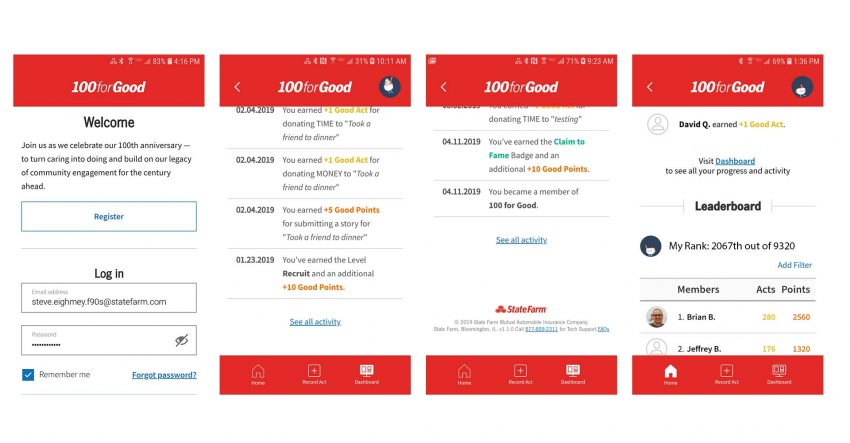- Industry: Insurance
- Problem: My company wanted another way to support a corporate culture of giving back to the community
- Role: UX architect
- Information architecture
- User flows
- Wireframes
- Outcome: The rapid design and deployment of a progressive web app (PWA) available only to employees that allowed them to record ‘acts of good’
A well-crafted company culture is more than just a set of values or policies; it has the power to captivate employees, foster passionate loyalty, and drive both personal and organizational success. However, building and sustaining such a culture is a delicate endeavor that requires careful nurturing, ethical practices, and a genuine commitment to employee well-being. In this post, I’ll share insights from my experience from being part of the design team for “100 for Good,” a progressive web app that aimed to strengthen our corporate culture through community engagement and positive action.
The Challenge: Cultivating a Culture of Positive Action
When tasked with the information architecture and initial design for “100 for Good,” I saw an opportunity to create a platform that could serve as a powerful tool for reinforcing our company’s values and fostering a sense of community among employees. The app was developed as part of our centennial celebration, with a mission to encourage employees to perform “100 acts of good” in their communities. The concept was straightforward: empower employees to engage in acts of kindness, big or small, and recognize them for their contributions.
Defining what constituted an “act of good” was deliberately left open to interpretation. This was a strategic decision rooted in understanding that meaningful actions are inherently subjective. Some employees might see helping a disabled neighbor with shopping as an impactful contribution, while others might consider something as simple as pulling a weed from their lawn a worthwhile deed. By keeping the definition broad, we aimed to lower the barrier to entry, encouraging widespread participation and fostering a culture of inclusivity and positive action.
Designing for Engagement: Gamification and User-Centric Features
To drive engagement, I incorporated elements of gamification into the app’s design. Gamification—using game-like elements in non-game contexts—has been proven to enhance motivation and engagement by tapping into users’ intrinsic and extrinsic motivations. In “100 for Good,” employees could earn points and badges as they completed acts of good, progressing through various levels. This approach provided immediate positive reinforcement, a key element in behavior change theory, and helped sustain user interest over time.
The introduction of a dynamic leaderboard was another critical feature. By displaying the rankings of participants, we not only encouraged a friendly sense of competition but also fostered camaraderie and a sense of belonging. Employees could see how their peers were contributing, which created a ripple effect of positive behavior and mutual encouragement.
The user experience was streamlined to minimize friction. Recording an act of good was designed to be quick and easy, optimized into three simple steps. On a mobile app, where user attention spans are short and input methods are limited, reducing the need for extensive typing was crucial. This design choice helped ensure that employees could effortlessly log their contributions, thereby maintaining a high level of engagement.
Iterative Development: Responding to User Behavior
The initial launch of the app exceeded all expectations, with rapid adoption and high levels of participation right from the start. We had initially planned a set of points and levels that we believed would be sufficient for about six months of usage. However, employees quickly began reaching the upper levels much sooner than anticipated. This unpredicted user behavior required us to respond quickly and iteratively to maintain engagement and momentum.
To address this, we introduced additional levels and badges, expanding the gamification elements to keep the experience fresh and rewarding. This iterative approach to design—observing user behavior, gathering feedback, and making continuous improvements—was vital to the app’s ongoing success. It’s a reminder of the importance of flexibility and responsiveness in UX design, especially when dealing with dynamic user communities.
Unprecedented Success: A Testament to Collaboration and Leadership
The growth and engagement achieved with “100 for Good” were unparalleled in the company’s history. What might typically have taken a year to achieve in terms of user adoption and engagement was accomplished in about five months. This remarkable outcome was the result of a combination of factors: a talented and dedicated team, a clear and compelling vision, and strong leadership that effectively removed bureaucratic and technical obstacles.
The success of “100 for Good” also highlights the importance of aligning UX design with organizational goals. By creating an app that not only engaged employees but also reinforced our company’s values and mission, we were able to build a stronger, more cohesive corporate culture. This alignment is key to achieving meaningful results that resonate both internally and externally.
Key Takeaways: Building a Culture of Engagement and Purpose
- Empower Employees Through Inclusivity: Design experiences that are accessible and meaningful to all employees, regardless of their role or level in the organization. A broad, inclusive approach encourages participation and fosters a sense of belonging.
- Use Gamification Strategically: Incorporate game-like elements to enhance motivation and engagement, but ensure they align with the overall goals of the initiative. Points, badges, and leaderboards can drive sustained interest and participation.
- Design for Simplicity and Ease of Use: Streamline processes to minimize friction, especially on mobile platforms. Quick, intuitive interactions reduce cognitive load and encourage continued engagement.
- Be Agile and Responsive: Monitor user behavior and be prepared to iterate quickly. Flexibility in design allows you to respond to changing needs and maintain user interest over time.
- Align Design with Organizational Values: Ensure that your UX design not only meets user needs but also supports the company’s broader mission and goals. This alignment creates a more cohesive and purpose-driven user experience.
Conclusion: The Power of Purposeful Design
Creating a thriving company culture and cultivating employee engagement requires more than just policies and programs; it demands thoughtful, user-centered design that aligns with the values and goals of the organization. By treating employees with care and respect and providing them with meaningful opportunities to contribute, you can build a culture that not only drives business success but also fosters personal fulfillment and loyalty. The “100 for Good” project is a testament to the power of purposeful design in creating a positive, impactful corporate culture. As UX designers, we have the unique opportunity to shape these experiences and contribute to a more engaged and motivated workforce.



